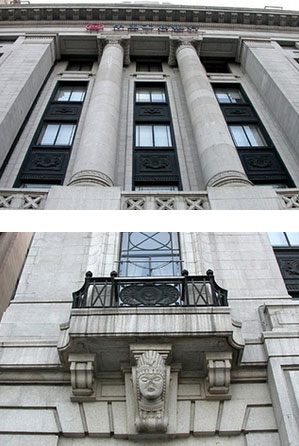
It is now the Industry and Commerce Bank of China Building, Formerly named Yokohama Specie Bank Building.
This Japanese bank’s Shanghai branch, which opened in 1893, had two former homes on the Bund before settling on the site of the former David Sassoon Building in 1911. The foundation stone of the present bank building was laid on ll’February 1923 by its president, Mr. Penji Kodama, and it was formally opened in July 1924 by its general manager, Mr. Cengo Hashidzume. The Yokohama Specie Bank was an extremely important institution as the major portion of Japan’s trade to China was transacted through its doors. The bank earned a reputation as‘the listening bank’of its time. Even though Palmer and Turner’s Tug Wilson listed the bank as one of his buildings, much of the design work was undertaken by his colleague, Frank Collard. Collard carefully crafted and successfully adapted many Japanese features to his general neo-Crecian exterior design.
The most striking examples can be found on the keystones above the building’s two ground floor windows. The original, sculpted granite heads, although severely disfigured, are still in place. When the bank opened, a commentator, on seeing the downcast eyes of the figures, remarked that they may‘seem to echo the placidity of Buddha but which mayhap express only the calm resignation of the modern banker. The features of similar figures, wearing helmets originally found on the fluted capitals of the two classic Iconic columns running up the centre of the building, have been completely erased, though evidence of their existence still remains. No such evidence is left above the oriel windows to the sides of the building on the first floor where beautifully sculpted copper canopies used to rest. Although the vast, black iron entrance gates set in bronze and cast by Critall-Freeman Bronze of London are still in place, their three magnificent central panels have been replaced.
The original bronze panels depicted the mask and arms of the ancient Japanese warrior as guardians of the institution, and had a rather‘Viking’appearance. Two small replicas of the originals have been recently recreated in a small lobby off the north side of the entrance hall. The pair of lamp standards outside the bank today are poor replicas of the originals, which featured finely cast figures modelling ancient Egyptian and contemporary Taiwanese aboriginal costumes, It is little surprise that the new lamps feature four, more appropCate, to the Chinese mind, nude Herculean figures in their place. The other major change to the outward decoration of the building is on the crest where the original shell-shaped, bronze backdrop, adorned with the Japanese sunburst, flanked by an Imperial Phoenix on each side, has been modified to a plain design. Inside the bank the main hall differed from many others of its time in that it had few traces of grille work or ornamental brass. Most of the business was conducted over open, broad, polished hardwood counters punctuated by large square columns of variegated marble.
The original grey and white veined marble which was shipped in from England has been totally replaced in the banking hall, but some remnants are to be found in the entrance hall. The sculpted, black bronze caps on the marble columns are now painted over in glitzy gold. Many original motifs on the ceiling have survived, as does the central feature of a domed light by the British Luxfer Prism Syndicate. The company also produced a similar ceiling fearure for the Hongkong and Shanghai Bank. British manufacturers figured largely in the building although the protective carborundum blocks covering the vaults were made in the great electric furnaces at Niagara Falls.
The building is now housing the Industrial & Commercial Bank of China.